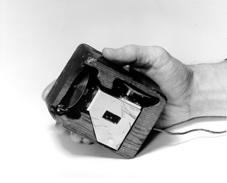Programming of Interactive Systems, Fall 2014
M1 and M1 HCID, Université Paris-Sud
Description
The course focuses on the design and programming of interactive systems. Classes are given by Theophanis Tsandilas and tutorials by Cédric Fleury and Arnaud Prouzeau.
Lectures and lab tutorials take place on Fridays from 2 to 6 pm at PUIO (Bat. 640) in rooms E210 or B107 (lectures) and E201-202 (labs).
You can contact Theophanis, Cédric and Arnaud by email (FirstName.LastName@lri.fr). Please, don't forget to include the [IS] in your message title!

by Douglas Englebart in 1964
[http://www.dougengelbart.org]
The class is partly based on last year's class by Anastasia Bezerianos, as well as older classes by M. Beaudouin-Lafon, N. Roussel, T. Tsandilas, and O. Chapuis. The following people have contributed to the design of the lab exercises: D. Bonnet, C. Fleury, N. Roussel, C. Appert, O. Bau, M. Beaudouin-Lafon, G. Besacier, S. Gueddana, Y. Riche, and M. Nancel.
For more information about the content and schedule of the course see the course syllabus.
News
- The final exam will be 2.5 hours long. Authorized material: any document in paper form.
Lab tutorials
Tutorials are structured around small programming assignments, primarily in Java. You can find more information here.
Assignments
Assignments count for 33% of the final mark.
Classes
Sept 26. Introduction and definitions. Why are there so many user interface problems?
Why is programming user interaction difficult? The brief history of Human-Computer Interaction and future trends.
[Slides] [Slides 4 in 1]
- A Moving Target—The Evolution of Human-Computer Interaction by Jonathan Grudin
- Why is UX so hard for some developers? by Karl Fast (with several links to useful resources)
- A Brief Rant on the Future of Interaction Design by Bret Victor
- Videos: [Introducing the Book] [Sketchpad] [Engelbart's NLS] [DigitalDesk]
Oct 3. No lecture. The lab tutorial is extended to 4 hours.
Oct 10. UI Programming. Event-based programming. Java Swing. Placement guides and design principles. [Slides] [Slides 4 in 1]
- GUI Programming by Brad Myers (quite old)
- Oracle's guidelines for creating UIs in Java
- Apple's guidelines for Mac OS applications
- C.R.A.P. principles applied to graphic design and UI design
Oct 17. Model-View-Controller architecture. Direct manipulation. Modeling interaction: state machines. Interaction modes. [Slides] [Slides 4 in 1]
- Java Swing and MVC and how to use models in Swing
- The Humane Interface by Jef Raskin. Check p. 42-44 on modes and p. 66-68 on monotony.
- Jacob Nielsen on quasi-modes and the anti-mac interface
- Videos: [DimP] [ILoveSketch]
Oct 31. Shortcuts, gestures, gesture recognition, chunking & phrasing, crossing. Introduction to Java2D & SwingStates. [Gestures] [Gestures 4 in 1] [Java2D] [Java2D 4 in 1] [SwingStates slides]
In addition to the links provided in the slides, you can check the following articles:
- Gesture-based interaction (basic terminology and taxonomies of gestures)
- Survey on stroke gestures by Zhai et al.
This is some Java code for drawing smooth curves through a list of pre-defined points with cubic Bézier curves. It uses a simple spline-interpolation algorithm. For more sophisticated implementations, you can use specialized libraries such as the Appache Commons Mathematics Library (e.g., see SplineInterpolator).
Nov 7. The psychology of the user interface: perception, visual search, and motor performance. SwingStates (continued). [Psychology] [Psychology 4 in 1] [SwingStates example]
This is the Java code for the SwingStates example.
- Lecture notes from MIT
- The Human processor by Card and Moran
Nov 14. Continuing on menus. User-Centered Design: Analysis, Design, Prototyping. [Design] [Design 4 in 1]
- Scenario-based design by Rosson and Carroll
- Conceptualizing interaction - Chapter 2 (Draft). Interaction Design: Beyond Human-Computer Interaction by Preece, Sharp and Rogers.
- Lecture by Bill Buxton on the role of sketching, storyboarding and cheap prototyping in the design process.
Nov 21. Input: direct vs. indirect, absolute vs. relative, position vs. rate control, CD gain, pointer acceleration, mid-air pointing, direct input problems. [Input] [Input 4 in 1]
It is hard to find introductory resources for this material. However, the following articles can help you further understand some concepts introduced in the class.
- Input technologies and techniques by Hinckley and Wigdor
- The Impact of Control-Display Gain on User Performance in Pointing Tasks by Casiez et al. The first sections define and explain the role of Control-Display gains and acceleration functions. You don't have to read the studies.
- Given the discussion in the class, this reference is only for people who are really curious about the limits of human precision when using a mouse: How Low Can You Go? Human Limits in Small Unidirectional Mouse Movements by Aceituno et al.
Nov 28. Continuing on input: multi-touch, gesture elicitation, programming for cross-platform interaction. Intro to CSS and JavaScript. [Input-complete] [Input-complete 4 in 1] [Web Development]
Dec 5. Preparing for the final exam. [Exam Review] [Exam Review 4 in 1]
Dec 10. Design and usability principles, evaluating interactive systems. [Design & Usability Principle, Evaluation] [Design & Usability Principle, Evaluation - 4 in 1]
- Affordances by M. Soegaard, and Affordances and Design by V. Kaptelinin
- Design principles by T. Tognazzini. Please, read it!
- Usability by J. Nielsen
- How to Conduct a Heuristic Evaluation by J. Nielsen
- Cognitive Walkthrough vs. Heuristic Evaluation by J. Sauro
- Usability Testing by Nielsen Norman Group
Older exams
These are examples of exams from previous years: [Exam 2013 - English] [Exam 2013 - French] [Exam 2012]